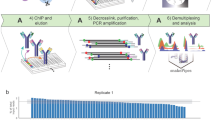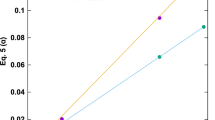Abstract
Recent progress in massively parallel sequencing platforms has enabled genome-wide characterization of DNA-associated proteins using the combination of chromatin immunoprecipitation and sequencing (ChIP-seq). Although a variety of methods exist for analysis of the established alternative ChIP microarray (ChIP-chip), few approaches have been described for processing ChIP-seq data. To fill this gap, we propose an analysis pipeline specifically designed to detect protein-binding positions with high accuracy. Using previously reported data sets for three transcription factors, we illustrate methods for improving tag alignment and correcting for background signals. We compare the sensitivity and spatial precision of three peak detection algorithms with published methods, demonstrating gains in spatial precision when an asymmetric distribution of tags on positive and negative strands is considered. We also analyze the relationship between the depth of sequencing and characteristics of the detected binding positions, and provide a method for estimating the sequencing depth necessary for a desired coverage of protein binding sites.
This is a preview of subscription content, access via your institution
Access options
Subscribe to this journal
Receive 12 print issues and online access
$209.00 per year
only $17.42 per issue
Buy this article
- Purchase on Springer Link
- Instant access to full article PDF
Prices may be subject to local taxes which are calculated during checkout






Similar content being viewed by others
References
Kim, T.H. & Ren, B. Genome-wide analysis of protein-DNA interactions. Annu. Rev. Genomics Hum. Genet. 7, 81–102 (2006).
Johnson, D.S., Mortazavi, A., Myers, R.M. & Wold, B. Genome-wide mapping of in vivo protein-DNA interactions. Science 316, 1497–1502 (2007).
Impey, S. et al. Defining the CREB regulon: a genome-wide analysis of transcription factor regulatory regions. Cell 119, 1041–1054 (2004).
Roh, T.Y., Cuddapah, S. & Zhao, K. Active chromatin domains are defined by acetylation islands revealed by genome-wide mapping. Genes Dev. 19, 542–552 (2005).
Bhinge, A.A., Kim, J., Euskirchen, G.M., Snyder, M. & Iyer, V.R. Mapping the chromosomal targets of STAT1 by sequence tag analysis of genomic enrichment (STAGE). Genome Res. 17, 910–916 (2007).
Eckhardt, F. et al. DNA methylation profiling of human chromosomes 6, 20 and 22. Nat. Genet. 38, 1378–1385 (2006).
Bentley, D.R. Whole-genome re-sequencing. Curr. Opin. Genet. Dev. 16, 545–552 (2006).
Johnson, W.E. et al. Model-based analysis of tiling-arrays for ChIP-chip. Proc. Natl. Acad. Sci. USA 103, 12457–12462 (2006).
Qi, Y. et al. High-resolution computational models of genome binding events. Nat. Biotechnol. 24, 963–970 (2006).
Peng, S., Alekseyenko, A.A., Larschan, E., Kuroda, M.I. & Park, P.J. Normalization and experimental design for ChIP-chip data. BMC Bioinformatics 8, 219 (2007).
Robertson, G. et al. Genome-wide profiles of STAT1 DNA association using chromatin immunoprecipitation and massively parallel sequencing. Nat. Methods 4, 651–657 (2007).
Smith, A.D., Xuan, Z. & Zhang, M.Q. Using quality scores and longer reads improves accuracy of Solexa read mapping. BMC Bioinformatics 9, 128 (2008).
Barski, A. et al. High-resolution profiling of histone methylations in the human genome. Cell 129, 823–837 (2007).
Mortazavi, A., Leeper Thompson, E.C., Garcia, S.T., Myers, R.M. & Wold, B. Comparative genomics modeling of the NRSF/REST repressor network: from single conserved sites to genome-wide repertoire. Genome Res. 16, 1208–1221 (2006).
Kim, T.H. et al. Analysis of the vertebrate insulator protein CTCF-binding sites in the human genome. Cell 128, 1231–1245 (2007).
Kent, W.J. BLAT—the BLAST-like alignment tool. Genome Res. 12, 656–664 (2002).
Bailey, T.L., Williams, N., Misleh, C. & Li, W.W. MEME: discovering and analyzing DNA and protein sequence motifs. Nucleic Acids Res. 34, W369–W373 (2006).
Matys, V. et al. TRANSFAC: transcriptional regulation, from patterns to profiles. Nucleic Acids Res. 31, 374–378 (2003).
Price, R.M. & Bonett, D.G. Estimating the ratio of two Poisson rates. Comput. Stat. Data Anal. 34, 345–356 (2000).
Acknowledgements
We would like to thank Dustin Schones and Keji Zhao for providing raw data and detailed descriptions for the CTCF data set, and Ali Mortazavi and Barbara Wold for providing sequence tag data for NRSF binding. This work was supported by grants from the National Institutes of Health to P.J.P. (U01HG004258, R01GM082798, UL1RR024920).
Author information
Authors and Affiliations
Corresponding authors
Supplementary information
Supplementary Text and Figures
Figures 1–20, Tables 1–3 (PDF 4157 kb)
Rights and permissions
About this article
Cite this article
Kharchenko, P., Tolstorukov, M. & Park, P. Design and analysis of ChIP-seq experiments for DNA-binding proteins. Nat Biotechnol 26, 1351–1359 (2008). https://doi.org/10.1038/nbt.1508
Received:
Accepted:
Published:
Issue Date:
DOI: https://doi.org/10.1038/nbt.1508
This article is cited by
-
Auxin-inducible degron 2 system deciphers functions of CTCF domains in transcriptional regulation
Genome Biology (2023)
-
peaksat: an R package for ChIP-seq peak saturation analysis
BMC Genomics (2023)
-
Systematic characterization of chromodomain proteins reveals an H3K9me1/2 reader regulating aging in C. elegans
Nature Communications (2023)
-
Dynamic de novo heterochromatin assembly and disassembly at replication forks ensures fork stability
Nature Cell Biology (2023)
-
Proteasome inhibition targets the KMT2A transcriptional complex in acute lymphoblastic leukemia
Nature Communications (2023)



